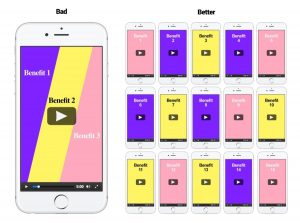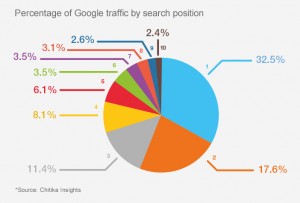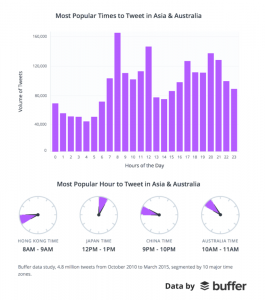No longer limited to a scrapbooking site, Pinterest has evolved into a tool to blend search and discovery into one platform. In particular, its Guided Search feature is a fairly new offering to desktop that’s helped turn Pinterest into a search engine for consumer intent.
Starting as a mobile-only way to search, Guided Search is a unique tool that allows users to redefine their search queries based on ideas provided by Pinterest. This often overlooked feature gives savvy marketers a chance to extend the value beyond the red walls of the social media site.
According to Pew Research Center, the proportion of adults who use the Internet has doubled over 3 years since 2012. As use continues to grow, user trends have evolved to expect more interactive, engaging, and visual content. With over 30 million Pins to choose from, Guided Search is the solution to bridge new content demands with search visibility. But how does it work and what does it mean for your brand?
A Guide to Guided Search
Here’s what sets Pinterest’s Guided Search apart from Google: With each query, Pinterest provides additional keywords to help direct users towards the results they want. On this social platform, each keyword typed into the search bar is just the starting point towards the right combination of ideas to find the right results.
Each time a keyword is entered into Pinterest, related keywords called guides appear under the search bar. This is where the magic happens: With a tap or click, these guides are added to the query to show new, more relevant results. It’s like adding a filter to search results to only get what you need to see.
On average, people click 3.6 guides daily with Guided Search. Because Guided Search was designed to be relevant for the mobile user experience, iPhone users are 50 percent more likely to click guides. Additionally, people are more likely to click on guides on the weekends.
Similar to Google’s predictive search, Pinterest will offer instantaneous potential guides to further refine the search around more relevant content and display results fast.
For example, when “Watches” is entered into the search bar, terms like “For Men,” “Luxury,” “Simple,” and “Vintage” appear under as a feature of Guided Search. By selecting one of those keywords, the results are transformed into a better-defined subset of Pins. This data can help markets better understand popular user intent and craft more personalized and engaging SEO strategies.
Not only that, but Pinterest learns from previous queries as well. If someone were to search “turkey” and were to tap a “Recipes” guide, the next person that searches “turkey” will see more turkey recipes. This optimizes user search time by taking the best guess at user intent with the data available with each search.
According to Forrester Research on Pinterest’s Guided Search, 30 percent of North American consumers have made a purchase after seeing an image on Pinterest. Companies with products that customers want to see and feel have an opportunity in Pinterest’s search engine.
This is where Pinterest becomes a threat to Google. Each Pin is loaded with visuals, which are easier to digest than words, so users can go through Pinterest results at-a-glance and digest content quicker than traditional web links found in Google results.
Like Google’s Keyword Planner, Guided Search can be used as a tool to generate valuable keyword research for specific industry vertices. Industries with a wide variety of competitive keywords such as travel, fashion, and food have an avenue to refine their SEO strategy with this undervalued tool.
This insight into real-world keyword application is a key differentiating factor. Though it was first implemented on mobile devices, the inspiration-infused search engine is a powerful tool capable of defining consumer intent with images and videos. By providing suggestions to refine searches, with just a click or a tap, Pinterest has streamlined the search process.
Consider it the next logical step from Google’s predictive search. Because Pinterest is catered towards sharing and discovering creative ideas, it results in actionable content people actually want to buy, do, or make.
Discovery Marketing’s Best Resource
Pinterest is a database of consumer intent. With that knowledge, web copy that converts now comes with a visual aid.
For SEO’s, Pinterest is a tool that can’t be ignored. Pins and boards have staying power similar to websites in a Google search, and can convert Repins into website visits. Six months after launching Guided Search, Pinterest’s search volume has increased by 25 percent, and 75 percent of all traffic comes from mobile devices.
Pins are not limited to just an image, title, and description either. With the new Buy It button on smartphones and tablets, Guided Search is supercharged with a “Buyable Pins” feature to turn Pinterest into a shopping cart. Just like the search function, Buyable Pins will have different options to select the right pattern, style, or color. Search can yet again be refined to only show items in the relevant price range for the user.
Not only that, but Pinterest has proven to inspire consumer action. According to Vision Critical, 47 percent of people who made Pinterest purchases said they “happened upon” an item that they pinned and purchased, while 28 percent responded that they were searching for the item they pinned and purchased.
Buyable Pins are an evolution of the technology embedded into Rich Pins. Rich Pins are Pins that can include app downloads, maps, addresses, phone numbers, prices, movie ratings, and ingredient lists to provide as much information as possible to the user. And, most importantly, they can have links back to websites.
Just like Google, natural links to credit sources are important to rank better in Guided Search. While simply including a link enriches a Pin, the most important factor is the SEO of your own site. Backlinks to stronger content will be more likely to show up in Pinterest’s search results.
BuzzFeed is still receiving conversions from a Pin posted in 2012 about DIY products. Unlike other social media, because all images are attached to links and passion, Pins don’t need Repins to get clicks. They just need high-quality images and high-quality links to start driving traffic for years to come.
Little known fact: If you want your content to appear in any Pinterest search result, you need to turn your search privacy settings OFF. By default, Pinterest has the search privacy turned on.
Optimize For Search Engine Exposure
It turns out that Pinterest is also a search engine within a search engine. (Inception?) Fresh content with relevant links is posted almost every day. Fresh results are easier and faster to digest because they are visual.
For the right queries (read: longtail), Pinterest’s result pages, Pins, and boards are likely to appear in Google search results. For example, “2 year old birthday ideas” provides a results page with Pinterest ranking on the first page. Similarly, searching “DIY planter bench” shows it as the second result.
With a little time investment, a board with a title proven to convert and a description infused with optimized keywords actually has potential to show up in Google’s own search results. With the right mix of Pins and powerful links to informative landing pages, the boost in referrals will continue for years to come.
When including Pinterest into your marketing strategy, it’s best to integrate more than just the keyword research from SEO. If you have copy you know converts, it may do well on Pinterest. It only gets better with visuals.
Because each board gets its own page, description, and title, it is important to strategically enhance each listing as they will show up as a meta description in search results.
According to Zabisco, 40 percent of people will respond better to visual information than plain text. This is because visuals are processed 60,000x faster in the brain. Because of Pinterest’s high quality images, links, and descriptions, each Pin delivers engaging content that users want to click.
It’s not a one-way street. Google realizes that when people use popular Pinterest keywords like “inspiration” and “theme,” those are cues for Google to look for something creative that may actually be best found on Pinterest. In this way, Boards are just as competitive as websites, blog posts, and directories.
Conclusion
Pinterest has a lot of untapped power in its search engine. Guided Search is the result of a decade and a half of search evolution. Now at the point where keywords represent both ideas and intent, suggesting search refinement on all devices is the next logical step for SEO to evolve into. Pinterest provides only a sneak peek.
Images have had the capability of doubling as links for a long time, and this is one of the first opportunities where they are both being boosted into a powerful social media and search platform. With interactive visuals and mobile raising the bar for how users expect to see their content, expect continued growth from Pinterest onsite and offsite. It would be remiss of Google to forego learnings from Pinterest’s search strategy to give a boost to their own image search before they’re replaced.
Digital & Social Articles on Business 2 Community(131)
Report Post







